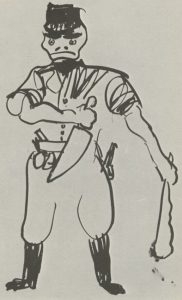I’m pleased to announce the release of the new issue of the journal Emotions: History, Culture, Society, which includes my article Anger as Misshapen Fear: Fascism, Literature, and the Emotional Body. 
Tag Archives: Eros e Priapo
Windows of the soul: caricature and physiognomy
Wednesday 28 February I was at Warwick University as an invited speaker within the research seminar series of the School of Modern Languages and Cultures. I publish here an excerpt of my talk, summarising the main point I tried to make and discussing some example of literary caricatures. Here the uncut version.
With this talk, I aim at clarifying the mutual enhancement of caricature and physiognomy. As Martin Porter puts it, physiognomy is a form of “natural magic”, a language in which all aspects of human appearance are natural “windows of the soul”. Physiognomy is assessed as “magic” and archaeological knowledge for the modern epistemology deprived it of recognised scientific reliability. Still, it has been a long-standing and pervading presence in Western Culture. Over time, it has registered the multiple and diverse attempts to connect what is visible of the human body to what is invisible and concerns the soul and the mind; to establish a relationship between the outside and the inside; to find homologies between superficial lines and deep forces, physical outlines and moral attitudes.

Lithographic drawings illustrative of the relation between the human physiognomy and that of the brute creation / From designs by Charles Le Brun. Wellcome Collection.
Anger as misshapen fear: fascism and the emotional body
What follows is the text of the paper I gave the 20 June 2017 at the International Conference «Fears and Angers. Historical and Contemporary Perspectives», Queen Mary University, 19-20 June 2017.
Probably Federico Fellini’s Oscar-winning movie, Amarcord, released in 1973, perfectly defines what was supposed to be the, as William Reddy would say, «emotional regime» of fascism. Enthusiasm, faith, happiness, and veneration for the Chief were the dominant public feelings endorsed by fascism. But, despite the public ceremonies being widely, and often sincerely, officiated by Italian people, fascism largely derived consensus from violence and intimidation.

Giacomo Manzù, Black Brigadist, 1943
The cognition of Priapus. Gadda and caricature
Is out my last essay, The Cognition of Priapus. Caricature procedures in Carlo Emilio Gadda’s Eros e Priapo. Here it is available the English abstract, while here you can find the whole essay in Italian.
I extract from the essay three different caricatural descriptions of Benito Mussolini provided by Gadda in his controversial pamphlet Eros e Priapo, written between 1944 and 1945. In the first, Gadda portraits the image of Mussolini speaking from the sadly well-known balcony:
Di colassù i berci, i grugniti, i sussulti priapeschi, lo strabuzzar d’occhî e le levate di ceffo d’una tracotanza priapesca: dopo la esibizione del dittatorio mento e del ventre, dopo lo sporgimento di quel suo prolassato e incinturato ventrone, dopo il dondolamento, in sui tacchi, e ginocchî, di quel culone suo goffo e inappetibile a chicchessia, ecco ecco ecco eja eja eja il glorioso, il virile manustupro: e la consecutiva maschia polluzione alla facciazza del «pòppolo».
